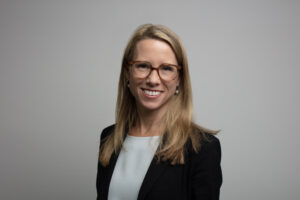Zurich Insurance Group has worked hard to turn around its financial results over the past five years by bringing underwriting back to the organization, with a greater focus on selecting the right risks, pricing them accordingly, properly structuring programs and applying the right terms and conditions, according to Sierra Signorelli, Zurich’s CEO Commercial Insurance.
Zurich improved its combined ratio in the commercial insurance business by 14 points compared to 2017 to 92 percent in the first half of 2021, which she attributed to keeping a “laser focus on underwriting actions.” (Combined ratios below 100 percent indicate underwriting profit).
“We’ve managed steady improvement of the combined ratio with all lines of business and regions contributing,” she continued. “Through our actions, we have strengthened our position relative to peers with higher growth, improved profitability in 2020, and a loss ratio that is almost six points lower than the peer group average.”
She emphasized, however, that Zurich’s improved results are not simply the effect of the rate increases flowing through the portfolio over the past several years. “These results come from hard work and discipline across the team over the past five years. I would also stress that it is difficult to grow, reduce volatility, and improve profitability all at the same time,” she said during a virtual investor presentation in November.

“I’ve been constantly messaging that it is always better to deliver bad news early. So we have a challenging situation, let’s have a conversation early, let’s make sure we work through multiple options for our customers, so they can decide what tradeoffs that they want to make.”
Sierra Signorelli, Zurich Commercial Insurance
Signorelli attributed the improvement in financials to underwriting discipline. “We have demonstrated underwriting discipline and focus over the past several years to deliver an outstanding result.”
While large commercial insurance premiums can be tempting in the near term, “price alone is never sufficient for a lack of underwriting and can leave insurers with a horrible hangover in future years,” she added.
She indicated it is critical that both Zurich and the industry continue to maintain this underwriting discipline, through all phases of the cycle. “As we think about today, it’s a very interesting time for commercial insurance. We have the positive impact of the current rate environment, and we’re generally seeing discipline across the market.”
During the investor day presentation and a recent interview, she dived into how the company has been working to re-underwrite its portfolio.
- Shifting Product Mix
“We have successfully shifted the product mix over the past years, reducing our casualty exposure while selectively growing property and specialty lines to better balance our portfolio,” she said, noting that the company was able to grow net earned premium by 10 percent in the first half of 2021 while continuing to focus on risk selection and risk quality to maintain the sustainably profitable portfolio through the cycle.
While pulling back on some lines of insurance, the company generally seeks to avoid completely exiting lines of insurance because of its customer relationships, including some that have bought insurance from Zurich for more than 100 years. “We are quite proud of the fact that we maintain these long-term relationships and we want to continue to do that,” she said.
- Improving Terms and Conditions
Further, Signorelli noted, the quality of the portfolio has been improved by tightening terms and conditions, “which will strengthen our portfolio now and in the future.”
For example, “COVID reinforced the importance of clarity in policy wording, both for us and for our customers.” Such precision is particularly important in the area of systemic risks, “which is why we’ve had an intense focus over the past several years on removing unintentional silent cyber in our wordings,” Signorelli said, noting that the insurer has been able to reduce cyber in property wordings by 90 percent.
- Reducing Volatility
To reduce volatility, Zurich has cut the maximum limit deployed on any one risk and the average limit deployed across the portfolio, particularly in cyber, D&O, liability and catastrophe-exposed risks. “Through this, our goal is to build a portfolio that is profitable in any cycle…,” she confirmed.
For example, in the cyber area, Zurich previously deployed up to $25 million in capacity, but has lowered that average limit to between $5 million and $7 million.
- Catastrophe-Exposed Risks
“In this environment where rates might seem tempting on the surface for cat exposed risks, it’s worth noting that as we grew our property portfolio, we did not accelerate our cat exposure,” she said.
She said Zurich has been actively managing its cat exposure in three ways: through modeling, underwriting and risk engineering.
In the area of modeling, Signorelli said that Zurich continuously enhances its models using recent claims data and external scientific data sets.
In underwriting cat exposures, Zurich has strengthened risk assessment, tightened terms and conditions and enhanced portfolio management with actionable insights. “This has allowed us to reduce critical flood exposure, rebalance US windstorm and reduce our exposure to wildfire.”
And finally, in the area of risk engineering, she said, Zurich has engaged with customers to help them mitigate their exposures, with an increasing interest from customers to understand their flood, wind and other natural hazard exposures. Zurich’s website describes risk engineering as solutions that help businesses “build resilience to today’s evolving, interconnected risk landscape by helping them manage loss control, mitigate risk, improve safety and reduce claims.”
Customer Focus
Signorelli joined Zurich as chief underwriting officer in July 2017, following Mario Greco’s appointment as the new CEO of Zurich Group in March 2016, who already had been taking steps to refresh the company’s approach in a number of areas.
“What was appealing about the role was that [Greco was] really looking to change the business, make a difference and think differently about our approach,” she said.
As a result of feedback from customers, Signorelli and her team worked hard to create consistency in the products offered, “clearly communicating where we’re willing to play and where we’re probably not the carrier to go with.”
“When I first joined the organization, there were a lot of questions with regard to what was Zurich’s appetite [for certain risks].”
She emphasized that profitable growth can be pursued at the same time as Zurich “leverages all of its capabilities to support our customers in managing their risks at a time when we see a changing risk landscape.”
“Business as usual will not be enough for what is coming. We are seeing the pressure that companies are facing today. We see a risk environment getting more complex and more unpredictable, whether it be natural catastrophes, emerging technologies, the digital economy, or new legal challenges that come with the ESG urgency to name a few,” she said. “Opportunity comes with risk, and we want to help our customers navigate these evolving risks.”
Zurich’s emphasis on building its data and analytics capabilities not only provides underwriters with the information they need to make better decisions about risk, but these capabilities also help them have more robust conversations with brokers and with customers about the trends they are seeing and why a risk might be priced or structured in a certain way, as well as helping customers understand how to reduce their exposure to certain risks, she explained.
Remembering the Basics
During her tenure, Signorelli has been focused on what customers need and staying relevant. “I’ve driven this with our teams in a number of ways. I’ve been constantly messaging that it is always better to deliver bad news early. So we have a challenging situation, let’s have a conversation early, let’s make sure we work through multiple options for our customers, so they can decide what tradeoffs that they want to make.”
During a hard market, this is a much better way to engage with customers, she emphasized. “Nobody wants a rate increase or to have a program restructured, but it’s even more important to have those conversations and to support them with some facts and be able to talk through [underwriting decisions].”
Further, Signorelli said, it’s important to avoid losing sight of the basics – the other customer “touch points.” “We must issue policies correctly and on time. We need to pick up the phone when customers call, and we must deliver a fair and prompt claim service. This may sound overly simple, but often we win new business because another company has failed to service the customer.”





















 Artificial Intelligence Is Rewriting the Rules for Commercial Lines
Artificial Intelligence Is Rewriting the Rules for Commercial Lines  California Workers Comp Combined Ratio for 2024 Highest in 20-Plus Years
California Workers Comp Combined Ratio for 2024 Highest in 20-Plus Years  Northern California Flooding This Weekend Caused by Heavy Rain, High Tides
Northern California Flooding This Weekend Caused by Heavy Rain, High Tides  NOAA Announces Latest AI-Driven Global Weather Models
NOAA Announces Latest AI-Driven Global Weather Models 



